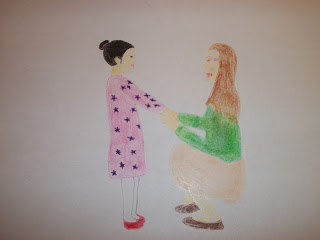Marianne von Werefkin
painting
1910
Staedtische Galerie im Lenbachhaus Kunstbau
Vincent van Gogh
Oil on canvas
1889
57 x 43.5 cm
National Gallery of Art, Washington, D. C.
Lovis Corinth
Oil on canvas
1896
66 x 86 cm
Staedtische Galerie im Lenbachhaus Kunstbau
Katherine Brown
colored pencil, crayon, marker on paper
2013
4 x 5.5 in.
I enjoy the bright, bold colors of the first self-portrait above by Marianne von Werefkin. I like how van Gogh's self-portrait that I selected has wavy, seemingly radiating lines similar to those in some of his other works. I like the irony of the self-portrait by Lovis Corinth shown above- it shows, presumably, how he looked at the time the painting was done and how he might look after death.
For my self-portrait I used crayon, colored pencil and marker because I am studying to be an elementary school teacher, so these media have been and will continue to be a part of my life.
It took some contemplating to decide what my pose should be and whether anyone else should be in my self-portrait. I knew I wanted to demonstrate that I love to help others, especially children. Looking at the works shown above helped me decide that I did want to use color, because I think it communicate liveliness. They also inspired me to reveal some aspects of my personality. The one crayon I was using was rubbing off a strange dark pigment, so I had to look for another similar one. I also found a picture to guide my drawing, since I am not skilled at drawing from memory.
My portrait hopefully reveals my love for children and desire to relate to and help them.
In my drawing, colors help to distinguish shapes. Simple lines hint at an elementary skill level, a child-like quality. I wanted the drawing to look like it could have been done by a child. The two figures are balanced on either side of the center of the work. There is an implied line created by their glances which meet. The clasped hands are emphasized as they are in the center.
I enjoyed attempting to portray my personality and goals in a self-portrait. I enjoy working with the materials that I used.
My drawing could have been more carefully executed had I had more time.




















